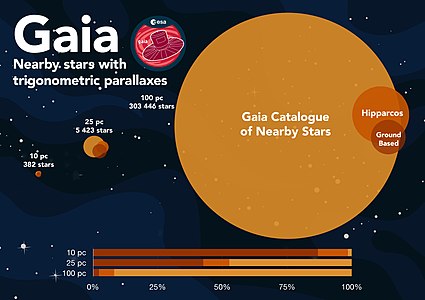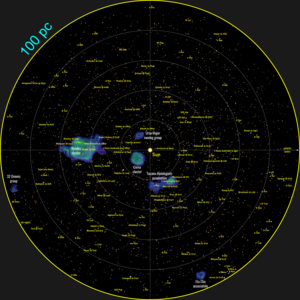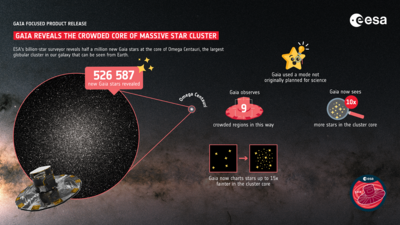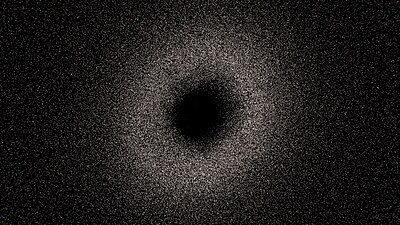Gaia catalogues

The Gaia catalogues are star catalogues created using the results obtained by Gaia space telescope.
The catalogues are released in stages that will contain increasing amounts of information; the early releases also miss some stars, especially fainter stars located in dense star fields.[1] Data from every data release can be accessed at the Gaia archive.[2]
Initial Gaia Source List[edit]
The Initial Gaia Source List (IGSL) is a star catalogue of 1.2 billion objects created in support of the Gaia mission. The mission should have delivered a catalogue based entirely on its own data. For the first catalogue, Gaia DR1, a way was needed to be able to assign the observations to an object and to compare them with the objects from other star catalogues. For this purpose, a separate catalog of objects from several other catalogues was compiled, which roughly represents the state of knowledge of astronomy at the beginning of the Gaia mission.[3]
Attitude Star Catalog[edit]
The Attitude Star Catalog is a subset of the IGSL, required for the first approximation in the iterative evaluation of the Gaia data. A first version was created in 2013, a more refined version in April 2014. In total, the Attitude Star Catalog contains 8,173,331 entries with information on position, proper motion and magnitude.[4] Starting with Gaia DR2, the Attitude Star Catalog was replaced with a new list generated from the Gaia Main Data Base (MDB), using the same criteria.
Gaia Spectrophotometric Standard Star Catalogue[edit]
IGSL contains a list of about 200 stars of different spectral classes and magnitudes needed for calibration of the photometric measurements. It is the result of the Gaia Spectrophotometric Standard Stars Survey (SPSS), a selection of stars using Earth-based data in advance of the Gaia mission. Previous catalogues for calibrating magnitudes could not be used for the mission because many of these objects are too bright for Gaia to detect. It was anticipated that some of the stars selected may be previously unrecognized doubles or variable stars that would need to be deleted from the catalogue; for this reason the list contains more stars than necessary.[5][6] For Gaia EDR3 (Early Data Release 3), a selection was made from more than 100,000 objects that were used for the calibration. These are well-observed objects selected according to Stetson Secondary Standards, but only Gaia data were used.[7]
Gaia Initial Quasar Catalog[edit]
A list of quasars based on the Large Quasar Astrometric Catalog was prepared for IGSL. This in turn goes back to the Sloan Digital Sky Survey. From the more than one million objects, a selection of 150,000 quasars was made, which are in the region of Gaia's magnitude limit. The selected objects are already well observed and documented. In most cases, quasars are very far away, so that their proper motions and parallaxes are negligibly small.[8][9]
Gaia Ecliptic Pole Catalogue[edit]
Gaia Ecliptic Pole Catalogue (GEPC) was created for measuring the poles. The southern part of the catalogue was compiled from observations made with the MPG/ESO telescope at the Max Planck Institute for Astronomy in La Silla, Chile. It contains precise positions, UBV I photometry for the southern field and the corresponding magnitudes. The northern part was created with the Canada–France–Hawaii Telescope on Mauna Kea, Hawaii.
The GEPC v3.0 catalogue contains 612,946 objects from a field of one square degree each at the north and south poles. The north pole is relatively sparse and contains 164,468 objects, while the south pole is still in the region of the Large Magellanic Cloud and contains 448,478 objects.[10] The GEPC data was needed right at the beginning of the mission for the initial calibration. The commissioning phase of the Gaia space probe ended on July 18, 2014. This was followed by a calibration phase of 28 days, during which the ecliptic poles were measured intensively. During this time, Gaia was operated in Ecliptic Poles Scan Law mode (EPSL), in which the two poles were measured twice during each revolution. The initial catalogue was used for Gaia DR1 to match Gaia-found objects to previous star catalogues.
Gaia DR1[edit]
Gaia DR1, the first data release based on 14 months of observations made through September 2015, took place on 13 September 2016.[11][12] It includes "positions and magnitudes in a single photometric band for 1.1 billion stars using only Gaia data, positions, parallaxes and proper motions for more than 2 million stars" based on a combination of Gaia and Tycho-2 data for those objects in both catalogues, "light curves and characteristics for about 3000 variable stars, and positions and magnitudes for more than 2000 extragalactic sources used to define the celestial reference frame".[13][14]
Gaia DR2[edit]

The second data release (DR2), which occurred on 25 April 2018,[15][16] is based on 22 months of observations made between 25 July 2014 and 23 May 2016. It includes positions, parallaxes and proper motions for about 1.3 billion stars and positions of an additional 300 million stars in the magnitude range g = 3–20,[17] red and blue photometric data for about 1.1 billion stars and single colour photometry for an additional 400 million stars, and median radial velocities for about 7 million stars between magnitude 4 and 13. It also contains data for over 14,000 selected Solar System objects.[18][19]
The coordinates in DR2 use the second Gaia celestial reference frame (Gaia–CRF2), which is based on observations of 492,006 sources believed to be quasars and has been described as "the first full-fledged optical realisation of the ICRS ... built only on extragalactic sources."[20] Comparison of the positions of 2,843 sources common to Gaia–CRF2 and a preliminary version of the ICRF3 shows a global agreement of 20 to 30 μas, although individual sources may differ by several mas.[21] Since the data processing procedure links individual Gaia observations with particular sources on the sky, in some cases the association of observations with sources will be different in the second data release. Consequently, DR2 uses different source identification numbers than DR1.[22] A number of issues have been identified with the DR2 data, including small systematic errors in astrometry and significant contamination of radial velocity values in crowded star fields, which may affect some one percent of the radial velocity values. Ongoing work should resolve these issues in future releases.[23] A guide for researchers using Gaia DR2, which collected "all information, tips and tricks, pitfalls, caveats and recommendations relevant to" DR2, was prepared by the Gaia Helpdesk in December 2019.[17]
Gaia DR3[edit]
Due to uncertainties in the data pipeline, the third data release, based on 34 months of observations, has been split into two parts so that data that was ready first, was released first. The first part, EDR3 (Early Data Release 3), consisting of improved positions, parallaxes and proper motions, was released on 3 December 2020.[24] The coordinates in EDR3 use a new version of the Gaia celestial reference frame (Gaia–CRF3), based on observations of 1,614,173 extragalactic sources,[24] 2,269 of which were common to radio sources in the third revision of the International Celestial Reference Frame (ICRF3).[25] Included is the Gaia Catalogue of Nearby Stars (GCNS), containing 331,312 stars within (nominally) 100 parsecs (330 light-years).[26][27]
The full DR3, published on 13 June 2022, includes the EDR3 data plus Solar System data; variability information; results for non-single stars, for quasars, and for extended objects; astrophysical parameters; and a special data set, the Gaia Andromeda Photometric Survey (GAPS), providing a photometric time series for about 1 million sources located in a 5.5-degree radius field centered on the Andromeda galaxy.[28][29] The release dates of EDR3 and DR3 were delayed by the effects of the COVID-19 pandemic on the Gaia Data Processing and Analysis Consortium.[30][31]
-
Stars and other objects in Gaia Early Data Release 3
-
Gaia Catalogue of Nearby Stars
-
Star density maps of the Gaia Catalogue of Nearby Stars. The Sun is located at the centre of both maps. The regions with higher density of stars are shown; these correspond with known star clusters (Hyades and Coma Berenices) and moving groups.
-
This image shows the orbits of the more than 150 000 asteroids in DR3, from the inner parts of the Solar System to the Trojan asteroids at the distance of Jupiter, with different colour codes.
Gaia Focused Product Release[edit]
Gaia Focused Product Release from October 2023 focused on Omega Centauri and contained more that half a million stars from that region.[32]
-
Focused Product Release
-
Gaia view of Omega Centauri from Gaia’s Data Release 3 in 2022
-
Gaia view of Omega Centauri from Gaia’s Focused Product Release in 2023
Gaia DR4 and DR5[edit]
The full data release for the five-year nominal mission, DR4, will include full astrometric, photometric and radial-velocity catalogues, variable-star and non-single-star solutions, source classifications plus multiple astrophysical parameters for stars, unresolved binaries, galaxies and quasars, an exo-planet list and epoch and transit data for all sources.[1] Most measurements in DR4 are expected to be 1.7 times more precise than DR2; proper motions will be 4.5 times more precise.[33]
The last catalogue, DR5, assuming an additional two-year extension of the Gaia mission until late-2024, will consist of full ten years of data. It will be 1.4 times more precise than DR4, while proper motions will be 2.8 times more precise than DR4.[33] It will be published not earlier than three years after the end of the mission.
Gaia Archive[edit]
The Gaia Archive is a catalogue that contains positions and brightnesses for 1.7 billion stars, including distances and proper motions for more than 1.3 billion stars.[34]
An outreach application, Gaia Sky, has been developed to explore the galaxy in three dimensions using Gaia data.[35]
See also[edit]
References[edit]
- ^ a b "Data Release scenario". Retrieved 3 December 2017.
- ^ "Gaia Archive".
- ^ R. L. Smart (2013-10-17). "The Initial Gaia Source List and the Attitude Star Catalog GAIA-C3-TN-OATO-RLS-004-02". Gaia DPAC Data Processing & Analysis Consortium.
- ^ R. L. Smart (2014-04-28). "The Attitude Star Catalog" (PDF). DPAC.
- ^ E. Pancino; et al. (2012). "The Gaia spectrophotometric standard stars survey - I. Preliminary results". Monthly Notices of the Royal Astronomical Society. 426 (3): 1767–1781. arXiv:1207.6042. Bibcode:2012MNRAS.426.1767P. doi:10.1111/j.1365-2966.2012.21766.x. S2CID 27564967.
- ^ C. Jordi; et al. "The Gaia Spectrophotometric Standard Stars" (PDF).
- ^ Marco Riello; F. De Angeli; D. W. Evans (2020-12-03). "Gaia Early Data Release 3: Photometric content and validation". Astronomy & Astrophysics. 649: A3. arXiv:2012.01916. doi:10.1051/0004-6361/202039587. ISSN 0004-6361. S2CID 248245902.
- ^ Mignard, F.; Klioner, S.; Lindegren, L.; Bastian, U.; Bombrun, A.; Hernández, J.; Hobbs, D.; Lammers, U.; Michalik, D.; Ramos-Lerate, M.; Biermann, M.; Butkevich, A.; Comoretto, G.; Joliet, E.; Holl, B.; Hutton, A.; Parsons, P.; Steidelmüller, H.; Andrei, A.; Bourda, G.; Charlot, P. (November 2016). "Gaia Data Release 1: Reference frame and optical properties of ICRF sources". Astronomy & Astrophysics. 595: A5. arXiv:1609.07255. Bibcode:2016A&A...595A...5M. doi:10.1051/0004-6361/201629534. S2CID 46661611.
- ^ Michalik, Daniel; Lindegren, Lennart (February 2016). "Quasars can be used to verify the parallax zero-point of the Tycho - Gaia Astrometric Solution". Astronomy & Astrophysics. 586: A26. arXiv:1511.01896. Bibcode:2016A&A...586A..26M. doi:10.1051/0004-6361/201527444. S2CID 119126039.
- ^ Altmann, M.; Bastian, Uli (17 February 2017). "2.2.4 The Gaia Ecliptic Pole Catalog (GEPC)" (PDF). Gaia Data Release 1 (Report). European Space Agency and Gaia Data Processing and Analysis Consortium. Retrieved 17 August 2022.
- ^ Jonathan Amos (14 July 2016). "Gaia space telescope plots a billion stars". BBC. Retrieved 2022-09-23.
- ^ "Gaia's billion-star map hints at treasures to come" (Press release). ESA. 13 September 2016. Retrieved 2022-09-23.
- ^ "Gaia Data Release 1 (Gaia DR1)". 14 September 2016. Retrieved 16 September 2016.
- ^ "Data Release 1". 15 September 2016. Retrieved 15 September 2016.
- ^ Overbye, Dennis (1 May 2018). "Gaia's Map of 1.3 Billion Stars Makes for a Milky Way in a Bottle". The New York Times. Retrieved 1 May 2018.
- ^ "You Are Here: Scientists Unveil Precise Map Of More Than A Billion Stars". NPR.org.
- ^ a b Gaia Helpdesk (9 December 2019), Gaia DR2 primer: Everything you wish you had known before you started working with Gaia Data Release 2 (pdf), vol. 1, retrieved 10 December 2019
- ^ "Gaia Data Release 2 (Gaia DR2)". 25 April 2018. Retrieved 26 April 2018.
- ^ "Selected asteroids detected by Gaia between August 2014 and May 2016". Retrieved 2 December 2017.
- ^ Gaia Collaboration; Mignard, F.; et al. (2018). "Gaia Data Release 2 – The celestial reference frame (Gaia-CRF2)". Astronomy & Astrophysics. 616 (A14): A14. arXiv:1804.09377. Bibcode:2018A&A...616A..14G. doi:10.1051/0004-6361/201832916. S2CID 52838272.
- ^ Lindegren, L.; Hernandez, J.; Bombrun, A.; Klioner, S.; et al. (2018). "Gaia Data Release 2 – The astrometric solution". Astronomy & Astrophysics. 616 (A2): A2. arXiv:1804.09366. Bibcode:2018A&A...616A...2L. doi:10.1051/0004-6361/201832727. S2CID 54497421.
- ^ Prusti, Timo; Brown, Anthony (3 February 2017). "Gaia DR2 Schedule". ESA. Retrieved 10 March 2018.
- ^ "Known issues with the Gaia DR2 data". European Space Agency. Retrieved 31 January 2019.
- ^ a b "Gaia Early Data Release 3 (Gaia EDR3)". ESA. Retrieved 12 December 2020.
- ^ Lindegren, L.; Klioner, S.; Hernandez, J.; Bombrun, A.; et al. (2021). "Gaia Early Data Release 3 – The astrometric solution". Astronomy & Astrophysics. A2: 649. arXiv:2012.03380. Bibcode:2021A&A...649A...2L. doi:10.1051/0004-6361/202039709. S2CID 227342958.
- ^ "Gaia EDR3 - Gaia Catalogue of Nearby Stars - Gaia - Cosmos". www.cosmos.esa.int.
- ^ Richard Smart, L. M. Sarro, J. Rybizki, C. Reyle, A. C. Robin (2021). "Gaia Early Data Release 3: The Gaia Catalogue of Nearby Stars". Astronomy & Astrophysics. A6: 649. arXiv:2012.02061. Bibcode:2021A&A...649A...6G. doi:10.1051/0004-6361/202039498. ISSN 0004-6361. S2CID 227255512.
{{cite journal}}: CS1 maint: multiple names: authors list (link) - ^ "Gaia Data Release 3 split into two parts". ESA. 29 January 2019. Retrieved 29 January 2019.
- ^ "Update to the Gaia data release scenario". ESA. 26 September 2019. Retrieved 28 September 2019.
- ^ "Delay of Gaia (E)DR3", Gaia Newsletter, no. #10, 18 March 2020, retrieved 21 March 2020
- ^ "Gaia Data Release 3 overview". 2022. Retrieved 23 February 2022.
- ^ "New Gaia release reveals rare lenses, cluster cores and unforeseen science". www.esa.int. Retrieved 15 October 2023.
- ^ a b Brown, Anthony G.A. (12 April 2019). The Future of the Gaia Universe. 53rd ESLAB symposium "the Gaia universe". doi:10.5281/zenodo.2637971.
- ^ "Gaia". irsa.ipac.caltech.edu. Retrieved 2020-12-15.
- ^ Sagristà Sellés, Toni (2016). "Gaia Sky". Heidelberg: Astronomisches Rechen-Institut (ZAH), Universität Heidelberg. Retrieved 2019-11-21.







